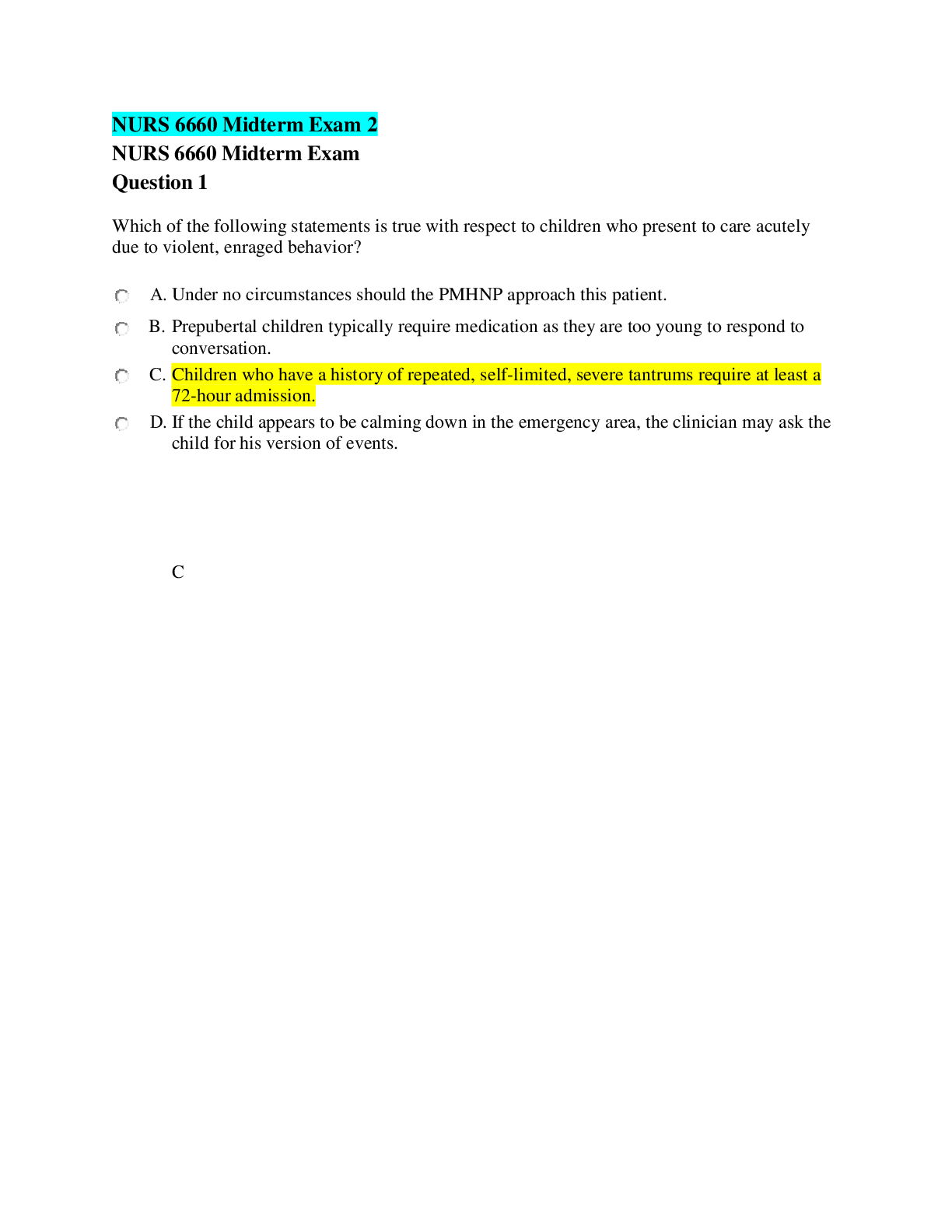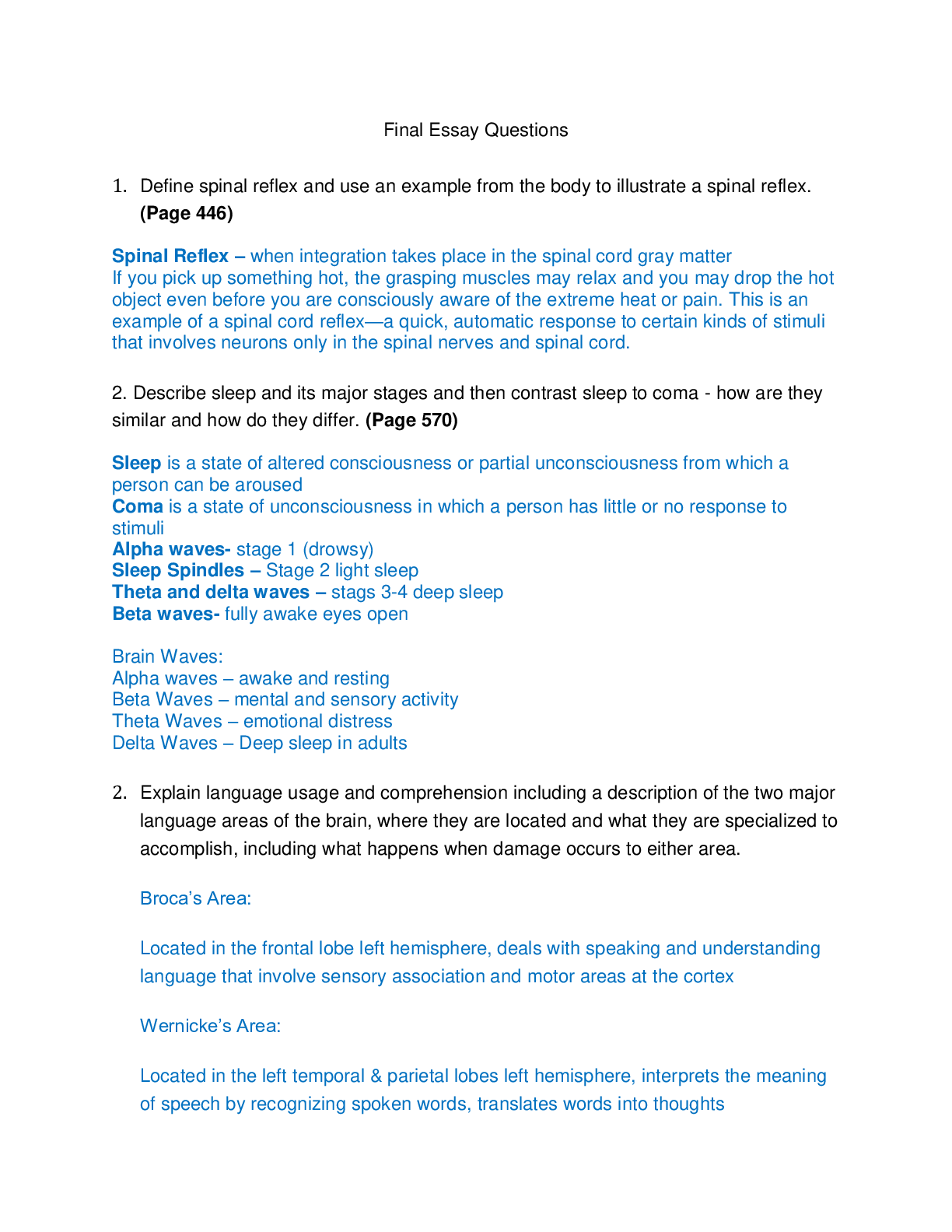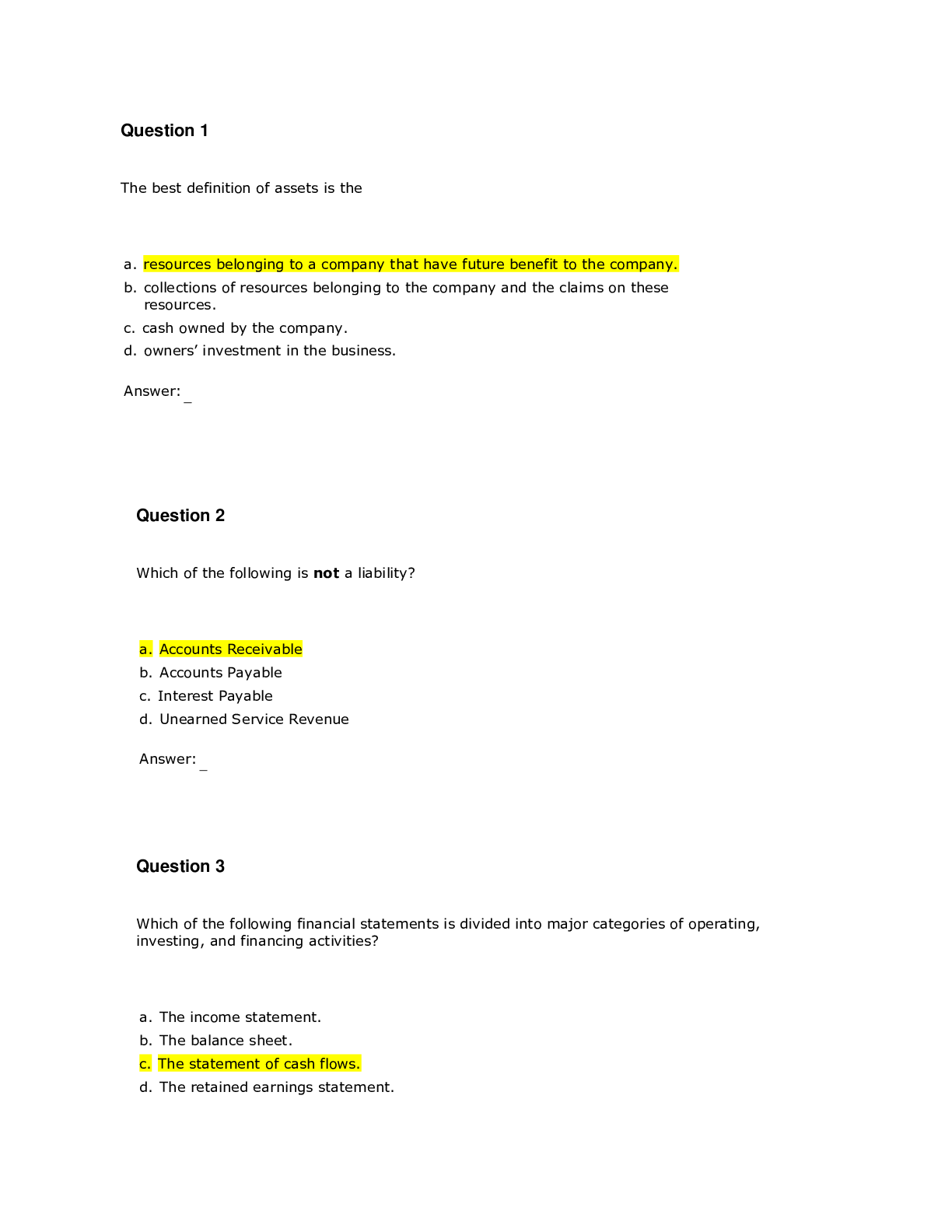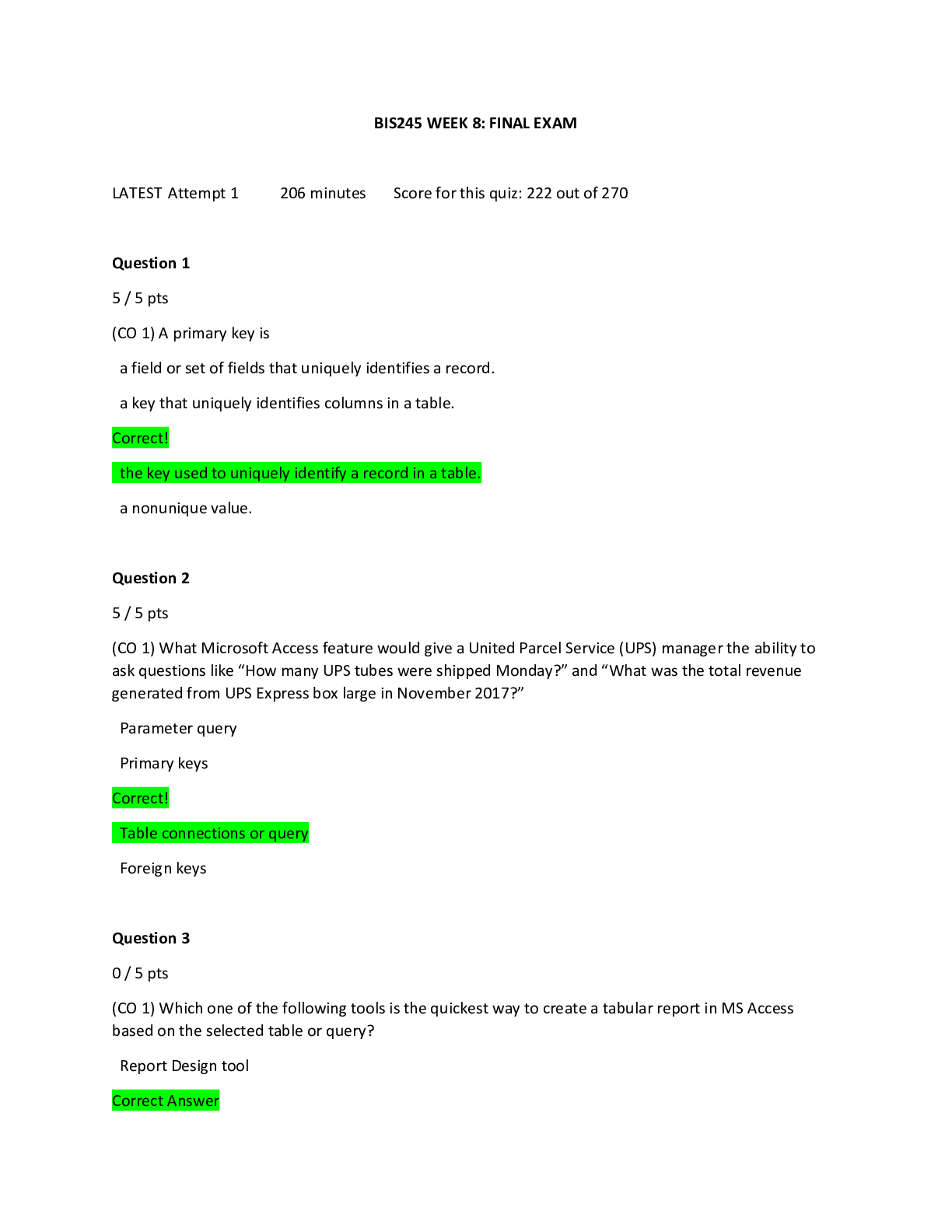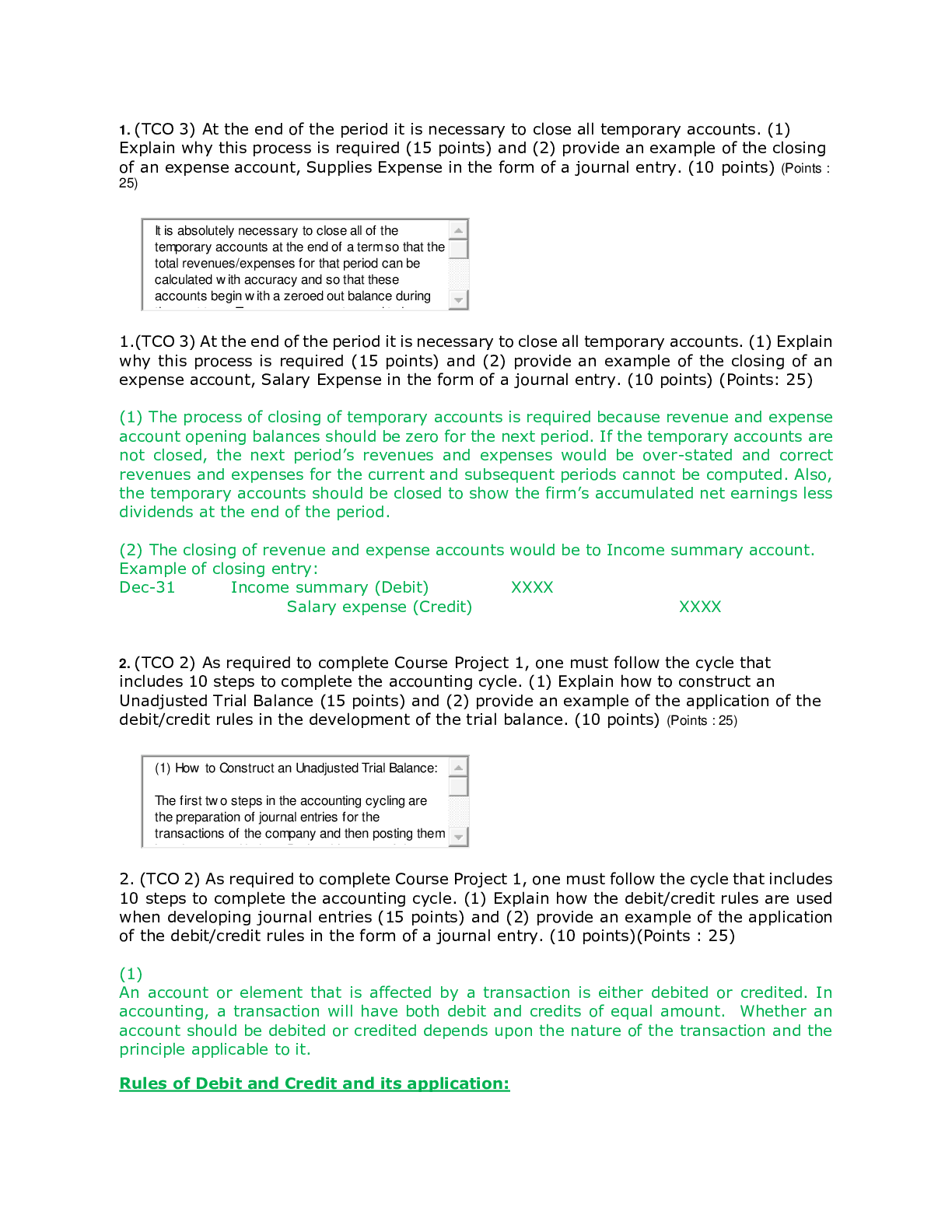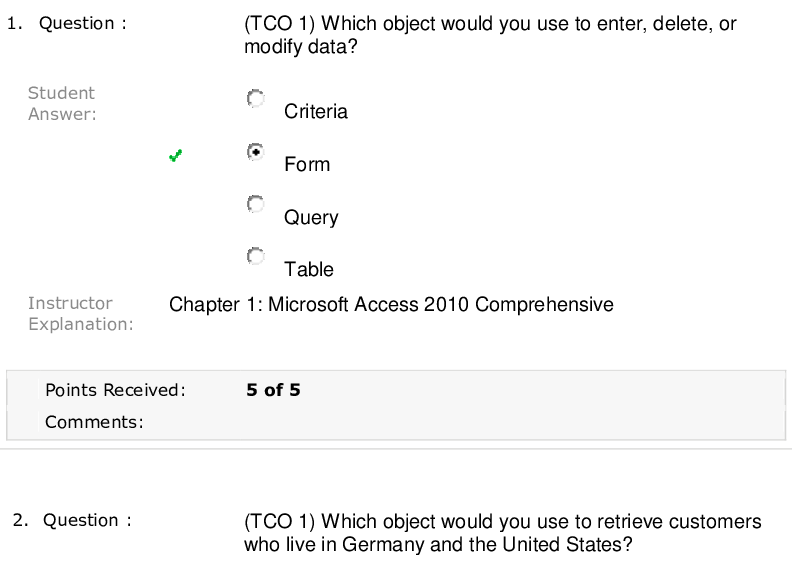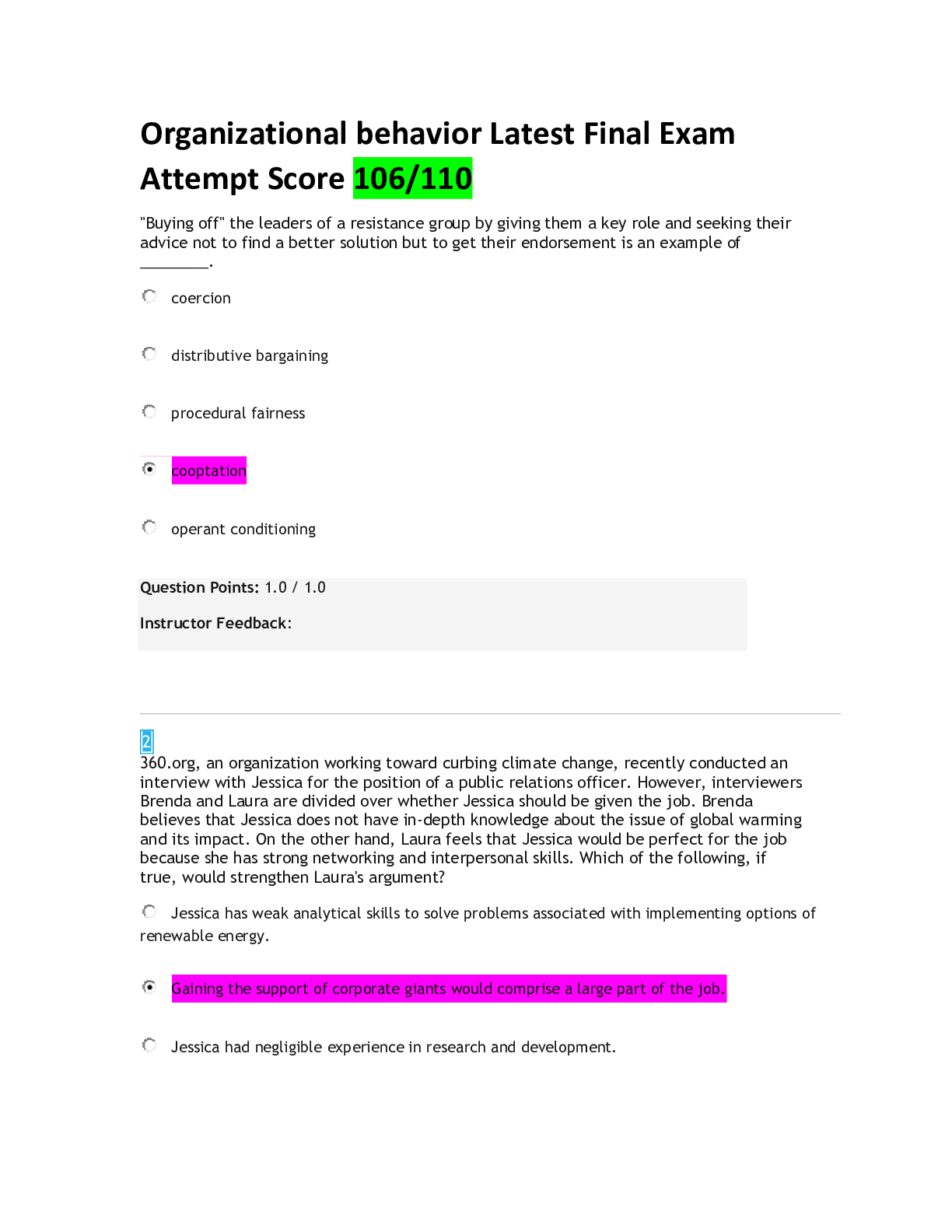NURS 6630 Final Exam | Score 72 out of 76 | Walden University
Document Content and Description Below
NURS 6630 Final Exam Test (2025) QUESTION 1 What will the PMHNP most likely prescribe to a patient with psychotic aggression who needs to manage the top-down cortical control and the excessive dr... ive from striatal hyperactivity? A. Stimulants B. Antidepressants C. Antipsychotics D. SSRIs QUESTION 2 The PMHNP is selecting a medication treatment option for a patient who is exhibiting psychotic behaviors with poor impulse control and aggression. Of the available treatments, which can help temper some of the adverse effects or symptoms that are normally caused by D2 antagonism? A. First-generation, conventional antipsychotics B. First-generation, atypical antipsychotics C. Second-generation, conventional antipsychotics D. Second-generation, atypical antipsychotics QUESTION 3 The PMHNP is discussing dopamine D2 receptor occupancy and its association with aggressive behaviors in patients with the student. Why does the PMHNP prescribe a standard dose of atypical antipsychotics? A. The doses are based on achieving 100% D2 receptor occupancy. B. The doses are based on achieving a minimum of 80% D2 receptor occupancy. C. The doses are based on achieving 60% D2 receptor occupancy. D. None of the above. QUESTION 4 Why does the PMHNP avoid prescribing clozapine (Clozaril) as a first-line treatment to the patient with psychosis and aggression? A. There is too high a risk of serious adverse side effects. B. It can exaggerate the psychotic symptoms. C. Clozapine (Clozaril) should not be used as high-dose monotherapy. D. There is no documentation that clozapine (Clozaril) is effective for patients who are violent. QUESTION 5 The PMHNP is caring for a patient on risperidone (Risperdal). Which action made by the PMHNP exhibits proper care for this patient? A. Explaining to the patient that there are no risks of EPS B. Prescribing the patient 12 mg/dail C. Titrating the dose by increasing it every 5–7 days D. Writing a prescription for a higher dose of oral risperidone (Risperdal) to achieve high D2 receptor occupancy QUESTION 6 The PMHNP wants to prescribe Mr. Barber a mood stabilizer that will target aggressive and impulsive symptoms by decreasing dopaminergic neurotransmission. Which mood stabilizer will the PMHNP select? A. Lithium (Lithane) B. Phenytoin (Dilantin) C. Valproate (Depakote) D. Topiramate (Topamax) QUESTION 7 The parents of a 7-year-old patient with ADHD are concerned about the effects of stimulants on their child. The parents prefer to start pharmacological treatment with a non-stimulant. Which medication will the PMHNP will most likely prescribe? A. Strattera B. Concerta C. Daytrana D. Adderall QUESTION 8 8 The PMHNP understands that slow-dose extended release stimulants are most appropriate for which patient with ADHD? A. 8-year-old patient B. 24-year-old patient C. 55-year-old patient D. 82-year-old patient QUESTION 9 A patient is prescribed D-methylphenidate, 10-mg extended-release capsules. What should the PMHNP include when discussing the side effects with the patient? A. The formulation can have delayed actions when taken with food. B. Sedation can be a common side effect of the drug. C. The medication can affect your blood pressure. D. This drug does not cause any dependency. QUESTION 10 The PMHNP is teaching parents about their child’s new prescription for Ritalin. What will the PMHNP include in the teaching? A. The second dose should be taken at lunch. B. There are no risks for insomnia. C. There is only one daily dose, to be taken in the morning. D. There will be continued effects into the evening. QUESTION 11 A young patient is prescribed Vyvanse. During the follow-up appointment, which comment made by the patient makes the PMHNP think that the dosing is being done incorrectly? A. “I take my pill at breakfast.” B. “I am unable to fall asleep at night.” C. “I feel okay all day long.” D. “I am not taking my pill at lunch.” QUESTION 12 A 14-year-old patient is prescribed Strattera and asks when the medicine should be taken. What does the PMHNP understand regarding the drug’s dosing profile? A. The patient should take the medication at lunch. B. The patient will have one or two doses a day. C. The patient will take a pill every 17 hours. D. The dosing should be done in the morning and at night. QUESTION 13 The PMHNP is meeting with the parents of an 8-year-old patient who is receiving an initial prescription for D-amphetamine. The PMHNP demonstrates appropriate prescribing practices when she prescribes the following dose: A. The child will be prescribed 2.5 mg. B. The child will be prescribed a 10-mg tablet. C. The child’s dose will increase by 2.5 mg every other week. D. The child will take 10–40 mg, daily. QUESTION 14 A patient is being prescribed bupropion and is concerned about the side effects. What will the PMHNP tell the patient regarding bupropion? A. Weight gain is not unusual. B. Sedation may be common. C. It can cause cardiac arrhythmias. D. It may amplify fatigue. QUESTION 15 Which patient will receive a lower dose of guanfacine? A. Patient who has congestive heart failure B. Patient who has cerebrovascular disease C. Patient who is pregnant D. Patient with kidney disease QUESTION 16 An 18-year-old female with a history of frequent headaches and a mood disorder is prescribed topiramate (Topamax), 25 mg by mouth daily. The PMHNP understands that this medication is effective in treating which condition(s) in this patient? A. Migraines B. Bipolar disorder and depression C. Pregnancy-induced depression D. Upper back pain QUESTION 17 The PMHNP is treating a patient for fibromyalgia and is considering prescribing milnacipran (Savella). When prescribing this medication, which action is the PMHNP likely to choose? A. Monitor liver function every 6 months for a year and then yearly thereafter. B. Monitor monthly weight. C. Split the daily dose into two doses after the first day. D. Monitor for occult blood in the stool. QUESTION 18 The PMHNP is assessing a patient she has been treating with the diagnosis of chronic pain. During the assessment, the patient states that he has recently been having trouble getting to sleep and staying asleep. Based on this information, what action is the PMHNP most likely to take? A. Order hydroxyzine (Vistaril), 50 mg PRN or as needed B. Order zolpidem (Ambien), 5mg at bedtime C. Order melatonin, 5mg at bedtime D. Order quetiapine (Seroquel), 150 mg at bedtime QUESTION 19 The PMHNP is assessing a female patient who has been taking lamotrigine (Lamictal) for migraine prophylaxis. After discovering that the patient has reached the maximum dose of this medication, the PMHNP decides to change the patient’s medication to zonisamide (Zonegran). In addition to evaluating this patient’s day-to-day activities, what should the PMHNP ensure that this patient understands? A. Monthly blood levels must be drawn. B. ECG monitoring must be done once every 3 months. C. White blood cell count must be monitored weekly. D. This medication has unwanted side effects such as sedation, lack of coordination, and drowsiness. QUESTION 20 A patient recovering from shingles presents with tenderness and sensitivity to the upper back. He states it is bothersome to put a shirt on most days. This patient has end stage renal disease (ESRD) and is scheduled to have hemodialysis tomorrow but states that he does not know how he can lie in a recliner for 3 hours feeling this uncomfortable. What will be the PMHNP’s priority? A. Order herpes simplex virus (HSV) antibody testing B. Order a blood urea nitrogen (BUN) and creatinine STAT C. Prescribe lidocaine 5% D. Prescribe hydromorphone (Dilaudid) 2mg QUESTION 21 The PMHNP prescribed a patient lamotrigine (Lamictal), 25 mg by mouth daily, for nerve pain 6 months ago. The patient suddenly presents to the office with the complaint that the medication is no longer working and complains of increased pain. What action will the PMHNP most likely take? A. Increase the dose of lamotrigine (Lamictal) to 25 mg twice daily. B. Ask if the patient has been taking the medication as prescribed. C. Order gabapentin (Neurontin), 100 mg three times a day, because lamotrigine (Lamictal) is no longer working for this patient. D. Order a complete blood count (CBC) to assess for an infection. QUESTION 22 An elderly woman with a history of Alzheimer’s disease, coronary artery disease, and myocardial infarction had a fall at home 3 months ago that resulted in her receiving an open reduction internal fixation. While assessing this patient, the PMHNP is made aware that the patient continues to experience mild to moderate pain. What is the PMHNP most likely to do? A. Order an X-ray because it is possible that she dislocated her hip. B. Order ibuprofen (Motrin) because she may need long-term treatment and chronic pain is not uncommon. C. Order naproxen (Naprosyn) because she may have arthritis and chronic pain is not uncommon. D. Order Morphine and physical therapy. QUESTION 23 The PMHNP is assessing a 49-year-old male with a history of depression, post-traumatic stress disorder (PTSD), alcoholism with malnutrition, diabetes mellitus type 2, and hypertension. His physical assessment is unremarkable with the exception of peripheral edema bilaterally to his lower extremities and a chief complaint of pain with numbness and tingling to each leg 5/10. The PMHNP starts this patient on a low dose of doxepin (Sinequan). What is the next action that must be taken by the PMHNP? A. Orders liver function tests. B. Educate the patient on avoiding grapefruits when taking this medication. C. Encourage this patient to keep fluids to 1500 ml/day until the swelling subsides. D. Order a BUN/Creatinine test. QUESTION 24 The PMHNP is evaluating a 30-year-old female patient who states that she notices pain and a drastic change in mood before the start of her menstrual cycle. The patient states that she has tried diet and lifestyle changes but nothing has worked. What will the PMHNP most likely do? A. Prescribe Estrin FE 24 birth control B. Prescribe ibuprofen (Motrin), 800 mg every 8 hours as needed for pain C. Prescribe desvenlafaxine (Pristiq), 50 mg daily D. Prescribe risperidone (Risperdal), 2 mg TID QUESTION 25 A patient with chronic back pain has been prescribed a serotonin-norepinephrine reuptake inhibitor (SNRI). How does the PMHNP describe the action of SNRIs on the inhibition of pain to the patient? A. “The SNRI can increase noradrenergic neurotransmission in the descending spinal pathway to the dorsal horn.” B. “The SNRI can decrease noradrenergic neurotransmission in the descending spinal pathway to the dorsal horn.” C. “The SNRI can reduce brain atrophy by slowing the gray matter loss in the dorsolateral prefrontal cortex.” D. “The SNRI can increase neurotransmission to descending neurons.” QUESTION 26 The PMHNP has been asked to provide an in-service training to include attention to the use of antipsychotics to treat Alzheimer’s. What does the PMHNP convey to staff? A. The use of antipsychotics may cause increased cardiovascular events and mortality. B. A good option in treating agitation and psychosis in Alzheimer’s patients is haloperidol (Haldol). C. Antipsychotics are often used as “chemical straightjackets” to over-tranquilize patients. D. Both “A” & “C.” QUESTION 66 An 80-year-old female patient diagnosed with Stage II Alzheimer’s has a history of irritable bowel syndrome. Which cholinergic drug may be the best choice for treatment given the patient’s gastrointestinal problems? A. Donepezil (Aricept) B. Rivastigmine (Exelon) C. Memantine (Namenda) D. All of the above QUESTION 67 The PMHNP understands that bupropion (Wellbutrin) is an effective way to assist patients with smoking cessation. Why is this medication effective for these patients? A. Bupropion (Wellbutrin) releases the dopamine that the patient would normally receive through smoking. B. Bupropion (Wellbutrin) assists patients with their cravings by changing the way that tobacco tastes. C. Bupropion (Wellbutrin) blocks dopamine reuptake, enabling more availability of dopamine. D. Bupropion (Wellbutrin) works on the mesolimbic neurons to increase the availability of dopamine. QUESTION 68 Naltrexone (Revia), an opioid antagonist, is a medication that is used for which of the following conditions? A. Alcoholism B. Chronic pain C. Abuse of inhalants D. Mild to moderate heroin withdrawal QUESTION 69 A patient addicted to heroin is receiving treatment for detoxification. He begins to experience tachycardia, tremors, and diaphoresis. What medication will the PMHNP prescribe for this patient? A. Phenobarbital (Luminal) B. Methadone (Dolophine) C. Naloxone (Narcan) D. Clonidine (Catapres) QUESTION 70 A patient diagnosed with obsessive compulsive disorder has been taking a high-dose SSRI and is participating in therapy twice a week. He reports an inability to carry out responsibilities due to consistent interferences of his obsessions and compulsions. The PMHNP knows that the next step would be which of the following? A. Decrease his SSRI and add buspirone (Buspar). B. Decrease his SSRI and add an MAOI. C. Decrease his SSRI steadily until it can be discontinued then try an antipsychotic to manage his symptoms. D. Keep his SSRI dosage the same and add a low-dose TCA. QUESTION 71 The PMHNP is assessing a patient who will be receiving phentermine (Adipex-P)/topiramate (Topamax) (Qsymia). Which of the following conditions/diseases will require further evaluation before this medication can be prescribed? A. Kidney disease stage II B. Obesity C. Cardiovascular disease D. Diabetes type II QUESTION 72 The PMHNP prescribes an obese patient phentermine (Adipex-p)/topiramate ER (Topamax) (Qsymia), Why is topiramate (Topamax) often prescribed with phentermine (Adipex-P)? A. Phentermine (Adipex-P) dose can be increased safely when taken with an anticonvulsant. B. Phentermine (Adipex-P) works by suppressing appetite while topiramate (Topamax) acts by inhibiting appetite. C. Topiramate (Topamax) potentiates appetite suppression achieved by phentermine (Adipex-P). D. Topiramate (Topamax) helps prevent the unwanted side effects of phentermine (Adipex-P). QUESTION 73 The PMHNP is assessing a patient who has expressed suicidal intent and is now stating that he is hearing voices and sees people chasing him. The PMHNP identifies these symptoms to be associated with which of the following? A. Barbiturate intoxication B. Marijuana intoxication C. “Bath salt” intoxication D. Cocaine intoxication QUESTION 74 The PMHNP is caring for a patient who openly admitted to drinking a quart of vodka daily. Prior to prescribing this patient disulfiram (Antabuse), it is important for the PMHNP to: A. Evaluate the patient’s willingness to abstain from alcohol B. Counsel the patient on dietary restrictions C. Obtain liver function tests D. Assess for addiction to opioids QUESTION 75 An opioid-naive patient is taking MS Contin (morphine sulfate) to treat his pain that is secondary to cancer. Under what circumstances would the PMHNP order naloxone (Narcan) IM/SQ? A. The patient’s speech is slurred, and he is in and out of sleep. B. The patient’s appetite has decreased from eating 100% of his meal to 50% of his meal. C. The patient complains of not having a bowel movement for 4 days. D. The patient’s vital signs are 98.4F temp, 88 pulse, 104/62 blood pressure, and 8 respirations. QUESTION 76 When completing this exam, did you comply with Walden University’s Code of Conduct including the expectations for academic integrity? Yes No [Show More]
Last updated: 7 months ago
Preview 4 out of 19 pages

Loading document previews ...
Buy this document to get the full access instantly
Instant Download Access after purchase
Buy NowInstant download
We Accept:

Reviews( 0 )
$10.00
Can't find what you want? Try our AI powered Search
Document information
Connected school, study & course
About the document
Uploaded On
Jan 22, 2020
Number of pages
19
Written in
Additional information
This document has been written for:
Uploaded
Jan 22, 2020
Downloads
0
Views
146




